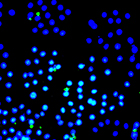miR-1270 enhances the proliferation, migration, and invasion of osteosarcoma via targeting cingulin

Accepted: 17 August 2021
HTML: 15
All claims expressed in this article are solely those of the authors and do not necessarily represent those of their affiliated organizations, or those of the publisher, the editors and the reviewers. Any product that may be evaluated in this article or claim that may be made by its manufacturer is not guaranteed or endorsed by the publisher.
Authors
Osteosarcoma (OS), characterized by high morbidity and mortality, is the most common bone malignancy worldwide. MicroRNAs (miRNAs) play a crucial role in the initiation and development of OS. The purpose of this study was to investigate the roles of miR-1270 in OS. RT-qPCR and Western blot were applied to detect the mRNA and protein level, respectively. CCK-8, colony formation, and TUNEL assays were conducted to determine the cell viability, proliferation, and apoptosis of OS cells. Wound healing and transwell assay were performed to detect the migration and invasion ability of OS cells. Bioinformatics analysis and dual-luciferase reporter assay were used to predict the target genes of miR-1270. Tumor xenograft in vivo assay was carried out to determine miR-1270 effect on the tumor size, volume, and weight. In this study, miR-1270 was overexpressed in OS tissues and cells. However, miR-1270 knockdown inhibited the proliferation, migration and invasion, and promoted the OS cells’ apoptosis. Mechanistically, cingulin (CGN) was predicted and proved to be a target of miR-1270 and partially alleviated the effects of miR-1270 on the proliferation, migration and invasion ability of OS cells. Taken together, knockdown of miR-1270 may inhibit the development of OS via targeting CGN. This finding may provide a novel therapeutic strategy for OS.
How to Cite

This work is licensed under a Creative Commons Attribution-NonCommercial 4.0 International License.
PAGEPress has chosen to apply the Creative Commons Attribution NonCommercial 4.0 International License (CC BY-NC 4.0) to all manuscripts to be published.

 https://doi.org/10.4081/ejh.2021.3237
https://doi.org/10.4081/ejh.2021.3237






